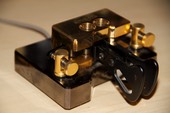This is a tale in relation to getting the best antenna in a small suburban back garden.
The only commercial antennas I have owned include the Hustler BTV-5 and
also a High Sierra Sidekick. The Hustler worked with average results,
but caused TVI and I sold it within a couple of months of buying it.
The Sidekick worked very well when mobile. Over the last few years I
have scratched an itch to home brew various antennas and have built
various single band dipoles, a home brew version of the renowned Cobweb
5 band folded dipole, Moxon rectangles for 10m & 6m, various
vertical antennas using a 40ft push-up mast, a fishing pole multi-band
dipole tuned using the SGC tuner and an eighty feet horizontal loop
about 6 feet in height. All of these were built in effort to make more
efficient use of my limited space and I had great fun along the way
with success on most bands above 20m.
My home brewing efforts have led me to support various published conclusions in regards to antennas;
- Have the antenna as high as possible
- Use the most amount of metal / wire possible
- Vertical antennas work, but receive interference and cause it
- Verticals and support structures are noticeable by neighbours
- Single horizontal or sloping wires are almost invisible
- Wire antennas including dipole's are the least expensive
- Dipole antennas don't suffer as much from windy conditions
- The highest field strength of the dipole is around its feed-point
- Balanced feed lines make sure nearly all the power is going out of the antenna elements
- Using 450ohm ladder line, presents a higher impedance to your ATU, which ATUs prefer
